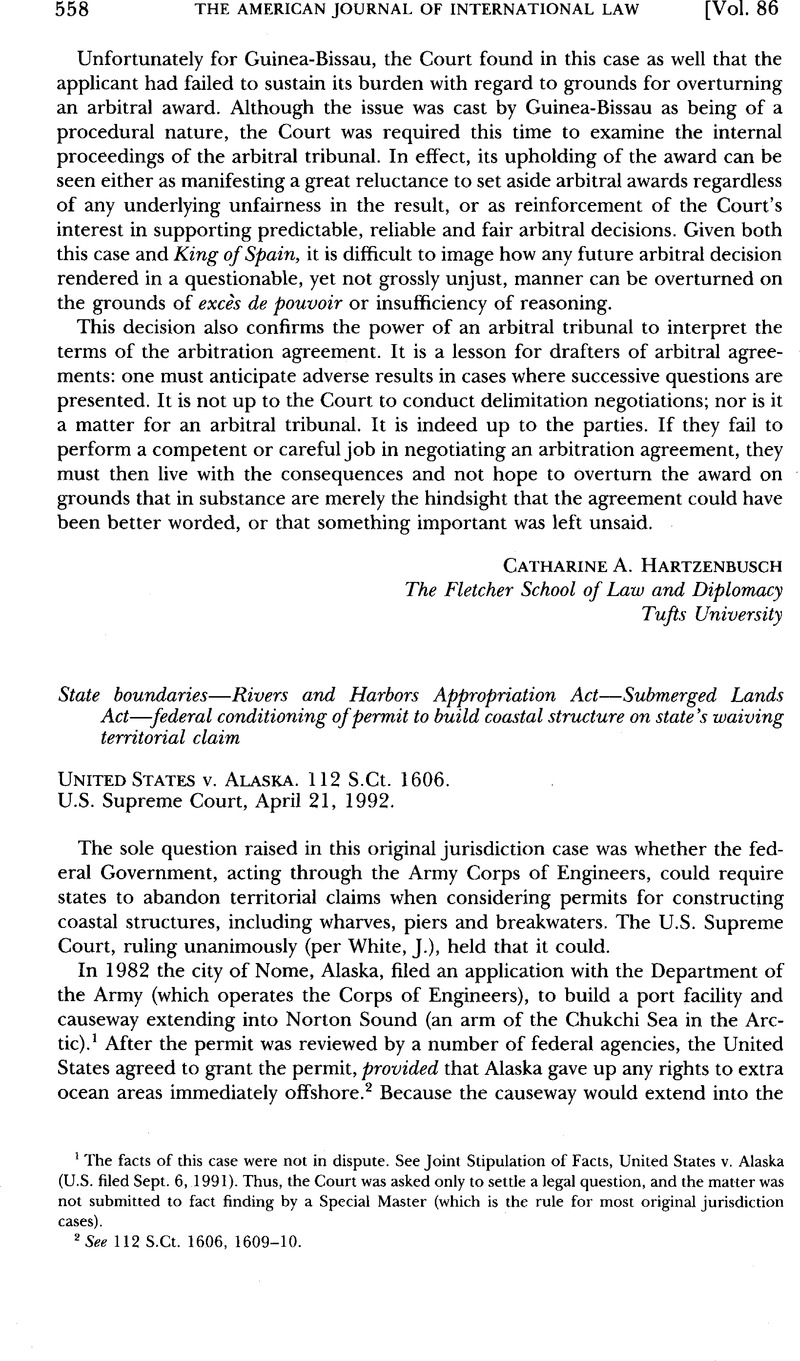No CrossRef data available.
Article contents
United States v. Alaska
Published online by Cambridge University Press: 27 February 2017
Abstract

- Type
- International Decisions
- Information
- Copyright
- Copyright © American Society of International Law 1992
References
1 The facts of this case were not in dispute. See Joint Stipulation of Facts, United States v. Alaska (U.S. filed Sept. 6, 1991). Thus, the Court was asked only to settle a legal question, and the matter was not submitted to fact finding by a Special Master (which is the rule for most original jurisdiction cases).
2 See 112 S.Ct. 1606, 1609–10.
3 See map submitted in Joint Stipulation, supra note 1, at 62a (App. O).
4 112 S.Ct. at 1609 n.2.
5 See id. at 1610 n.4.
6 332 U.S. 19 (1947).
7 Pub. L. No. 31, ch. 65, 67 Stat. 29 (1953) (codified as amended at 43 U.S.C. §§1301–1315 (1988)).
8 See 43 U.S.C. §1312. See also United States v. Florida, 425 U.S. 791 (1976).
9 U.S. Const. Art. 1, §8, cl. 3.
10 Ch. 425, §9, 30 Stat. 1121, 1151 (1899).
11 See 33 U.S.C. §403 (1988).
12 The United States chiefly relied on two cases, United States v. California, 381 U.S. 139 (1965) (California II), and United States ex rel. Greathouse v. Dern, 289 U.S. 352 (1933), both of which suggest that the federal Government has unfettered discretion to withhold permits for coastal con struction, even if the reason is to deny the states extra submerged lands they would otherwise be entitled to under the SLA.
13 Alaska also argued that the Department of the Army had not followed the clear language of its regulations for issuing section 10 permits and, even if it had, the regulations were issued in violation of the Administrative Procedure Act. Both contentions were dismissed by the Court. 112 S.Ct. at 1618–19.
14 Id. at 1615–16.
15 Both Alaska and the United States correctly observed that a causeway or harbor structure would form the new baseline from which the territorial sea and exclusive economic zone are drawn. See Convention on the Territorial Sea and Contiguous Zone, Apr. 29, 1958, Art. 8, 15 UST 1607, TIAS No. 5639, 516 UNTS 205 (“For the purpose of delimiting the territorial sea, the outermost perma nent harbour works which form an integral part of the harbour system shall be regarded as forming a part of the coast.”). This language was repeated in Article 11 of the 1982 UN Convention on the Law of the Sea, opened for signature Dec. 10, 1982, UN Doc. A/CONF.62/122, reprinted in United Nations, Official Text of the United Nations Convention on the Law of the Sea with An Nexes and Index, UN Sales No. E.83.V.5 (1983) (not yet in force).
16 California II, 381 U.S. at 165.
17 112 S.Ct. at 1617–18.
18 See Proclamation No. 5928 (Dec. 27, 1988), 54 Fed. Reg. 777 (1989).
19 The Court also said that the SLA itself provided that state/federal boundaries established pursuant to it were not to be ambulatory, 33 U.S.C. §1301(b), which would mean that a subsequent accretion of land would affect the U.S. international boundary, but not the SLA line. See 112 S.Ct. at 1617 n.11.
20 112S.Ct. at 1617–18.
21 See Brief of Amicus Curiae Coastal States Organization at 8–11, United States v. Alaska (U.S. filed Oct. 1991).


